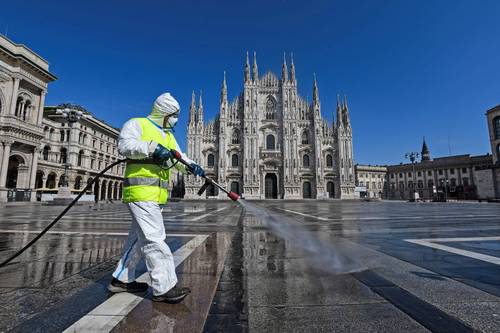▲ A worker sprays disinfectant in Piazza del Duomo, in Milan, at the start of the lockdown on March 31, 2020.Afp photo
Armando G. Tejeda
Correspondent
Newspaper La Jornada
Monday February 27, 2023, p. 4
Madrid. Europe has been one of the regions of the world most affected by the covid-19 pandemic, especially due to the virulence of the spread, the degree of mortality and the harshness of the social drama that caused one of the most serious health crises in recent decades. globally.
According to the World Health Organization, only in European countries – which Russia considers on this continent – the number of infections since the start of the pandemic has been more than 273 million, of which 2 million 187 thousand people have died. These data could be even worse if the hundreds of thousands of deaths that are not part of the official statistics and that warn of deaths are taken into account. with covid symptoms
but since they did not have a positive test confirming the diagnosis, they were not included in the official figure.
At the beginning of 2020, Europe, like the rest of the planet, lived on the margins of the latent threat posed by the covid virus, which until then was seen as an epidemic focused on China and not even on the entire Asian country, but on a small region, Wuhan, where the spread originated, according to scientific studies. European countries looked askance, oblivious to the threat and thinking that this virus would not leave China and if it did, it would not pose any threat to the region. Not even when the first cases on European soil became known, on January 25 in France and on February 13 in Spain, which both culminated in deaths, did the alarms go off in public systems, neither in governments nor in health institutions. the European Union (EU).
Furthermore, when preventive measures began to be activated in Italy as of February 21 and fear of an uncontrolled spread of the virus grew, the rest of the continent continued to live on the margins of the threat; No international fairs were cancelled, airports and international transportation hubs were unrestricted, as were hospitals, nursing homes, or schools. No public authority was capable of foreseeing that a few days later the lives of hundreds of millions of people in the world would radically change.
The EU confirmed the magnitude of the tragedy in a statement three years after the first detected case: A macabre milestone has been reached when it was confirmed that deaths from covid-19 in the countries of the European region have exceeded 2 million
and the trickle of deaths, although with much less intensity, continues to this day, when everyone agrees that the virus is still alive throughout the world.
Italy, the origin of the focus in Europe
On February 21, 2020, the pandemic officially began in Italy. Despite the fact that isolated cases were detected and that the first deaths from covid were even reported in Spain and Germany, it was in Italy where the pandemic spread virulently. Not even the measures adopted, which included the state of emergency
At the beginning of February, when two Chinese tourists were detected with the disease and were confined to the Spallanzani hospital in Rome, they prevented the eyes of the world from looking in awe and fear at the spread of the disease in Italy days later.
It was not until February 21 that the first Italian patient hospitalized with covid-19 was identified: Mattia Maestri, a 38-year-old Italian citizen. This precipitated the first big and drastic measures in the northern town of Codogno, in the Lombardy region, and from there they spread to the bordering regions and then to the whole country. This Italian province was the first in Europe to decree the closure of shops, schools and any public activity, and finally the confinement of citizens to their homes, which could only be skipped for exceptional reasons or vital emergencies.
It was precisely in the town of Codogno, in the heart of Lombardy, the financial and economic lung of the country, where those first weeks of the epidemic were experienced with special drama. And not only because of the very high and rapid number of infections, but also because of the high mortality and the lack of measures on the part of the administration. In those days, the Italian government was debating between adopting draconian and severe measures or going little by little and analyzing its evolution, especially due to the pressures of industrial and economic powers. And so it was done, at least in the early days, when it looked the other way while the factories continued to work almost routinely. At least until the decrees were signed that isolated nearly 16 million citizens and paralyzed for two months an area that included the entire Lombardy region and 14 other northern Italian provinces: Modena, Parma, Piacenza, Reggio Emilia, Rimini, Pesaro-Urbino, Venice, Padua, Verbano-Cusio-Ossola, Treviso, Vercelli, Novara, Asti and Alessandria.
But these restrictions could not prevent Italy from becoming the world epicenter of covid-19 in the first months of 2020. The first cases of infection in many countries came from precisely there, as happened even in Mexico, where the first official case of an infected person was a 35-year-old man who had participated in a professional congress in Italy and had had contact with a person with symptoms.
In those dramatic days, when Italy was in shock and fear, a brigade of Cuban doctors moved public opinion and the authorities for their work in trying to control the pandemic. Until the point that once the health crisis was over, the Italian government awarded Cuban doctor Julio Guerra Izquierdo the Order of the Star of Italy in the Knight Degree for the work carried out at the head of the medical brigade of the Henry Reeve Contingent .
The Italian central government, then chaired by Giuseppe Conte, did not consider it necessary to adopt national measures and limited itself to decreeing preventive actions in the vicinity of Codogno, that is, in just over half of Lombardy. But days later, when hospitals began to collapse and it was found that the spread of the virus was unstoppable, massive and fast, it was found that the entire country was in a situation of extreme vulnerability. So it was until March 9 that Italy became the first European country to confine its entire territory through a decree law in which, in addition to ordering citizens to respect the distance of more than one meter between people.
While Italy was already confined and under maximum tension, the rest of the European countries, including the border ones, did not strengthen their precautionary measures in the face of the threat. Just like it happened at the beginning of the year, when the whole world thought that this virus was a matter of China and China alone. In Spain, for example, an international contemporary art fair was held in Madrid at the end of February and beginning of March, with Italy as the guest country, which was attended by hundreds of gallery owners, artists and collectors from there and many from they from Lombardy. The same in Spain, as in the rest of the main European capitals, on March 8, massive demonstrations were held to commemorate International Women’s Day, without anticipating the very serious risk of spreading the deadliest disease in recent decades in the world. .
In mid-March, when hospitals and emergency services began to emit maximum alarm signals, the governments of European countries finally reacted and activated emergency measures, similar to those adopted in Italy. Those were the days of mass confinement, of going out to the balconies to applaud health personnel, of empty streets and full hospitals, of morgues and funeral homes working overtime so that corpses would not continue to accumulate.
The drama
According to WHO statistics, in Europe, which includes 53 countries, including Russia and several former Soviet republics, the number of deaths from the pandemic is 2 million 187 thousand people until the beginning of February, while it is estimated that in the world the figure rises to 14.9 million. And, according to these data, several technical reports, such as the one prepared by the University of Oxford to establish an Efficiency Index in the Management of the Pandemic (IEGP), it was concluded that among the countries with the best behavior of public institutions to face the pandemic were northern European countries, as well as Korea and New Zealand.
In fact, among the European countries with the best IEGP are Norway, Iceland, Denmark, Finland and Sweden, while those with the worst performance were precisely where the outbreak originated and also the most populous, especially Italy, Spain, France , Germany and the United Kingdom, with a higher percentage of mortality based on their demographic density.
But, in addition to public health, the main European institutions have devoted themselves in recent years to activating the million-dollar economic recovery plan, with specific measures to recover the gross domestic product (GDP) prior to the pandemic, through an agreement to authorize a general budget of about 2 billion euros for the years 2021-2027. A plan in which most countries, especially those hardest hit by the pandemic, such as Spain, Italy, Greece and Portugal, have their hopes pinned to definitively leaving behind a pandemic as voracious and destructive as that of covid-19.














